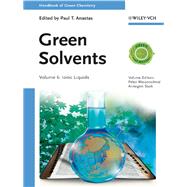
What is included with this book?
Ionic Liquids and Green Chemistry – an Extended Preface XIII
About the Editors XXI
List of Contributors XXIII
Part I Green Synthesis 1
1 The Green Synthesis of Ionic Liquids 3
Maggel Deetlefs and Kenneth R. Seddon
1.1 The Status Quo of Green Ionic Liquid Syntheses 3
1.2 Ionic Liquid Preparations Evaluated for Greenness 4
1.3 Which Principles of Green Chemistry are Relevant to Ionic Liquid Preparations? 6
1.4 Atom Economy and the E-factor 7
1.5 Strengths, Weaknesses, Opportunities, Threats (SWOT) Analyses 8
1.6 Conductive Heating Preparation of 1-Alkyl-3-methylimidazolium Halide Salts 8
1.7 Purification of 1-Alkyl-3-methylimidazolium Halide Salts 12
1.8 Ionic Liquid Syntheses Promoted by Microwave Irradiation 15
1.9 Syntheses of Ionic Liquids Promoted by Ultrasonic Irradiation 20
1.10 Simultaneous Use of Microwave and Ultrasonic Irradiation to Prepare Ionic Liquids 23
1.11 Preparation of Ionic Liquids Using Microreactors 25
1.12 Purification of Ionic Liquids with Non-halide Anions 28
1.13 Decolorization of Ionic Liquids 31
1.14 Conclusion 34
References 36
Part II Green Synthesis Using Ionic Liquids 39
2 Green Organic Synthesis in Ionic Liquids 41
Peter Wasserscheid and Joni Joni
2.1 General Aspects 41
2.2 Friedel–Crafts Alkylation 54
References 59
3 Transition Metal Catalysis in Ionic Liquids 65
Peter Wasserscheid
3.1 Solubility and Immobilization of Transition Metal Complexes in Ionic Liquids 65
3.2 Ionic Liquid–Catalyst Interaction 67
3.3 Distillative Product Isolation from Ionic Catalyst Solutions 70
3.4 New Opportunities for Biphasic Catalysis 72
3.5 Green Aspects of Nanoparticle and Nanocluster Catalysis in Ionic Liquids 75
3.6 Green Aspects of Heterogeneous Catalysis in Ionic Liquids 77
3.7 Green Chemistry Aspects of Hydroformylation Catalysis in Ionic Liquids 79
3.8 Conclusion 85
References 85
4 Ionic Liquids in the Manufacture of 5-Hydroxymethylfurfural from Saccharides. An Example of the Conversion of Renewable Resources to Platform Chemicals 93
Annegret Stark and Bernd Ondruschka
4.1 Introduction 93
4.2 HMF Manufacture 99
4.3 Goals of Study 105
4.4 HMF Manufacture in Ionic Liquids – Results of Detailed Studies in the Jena Laboratories 105
4.5 Conclusion 117
References 118
5 Cellulose Dissolution and Processing with Ionic Liquids 123
Uwe Vagt
5.1 General Aspects 123
5.2 Dissolution of Cellulose in Ionic Liquids 127
5.3 Rheological Behavior of Cellulose Solutions in Ionic Liquids 129
5.4 Regeneration of the Cellulose and Recycling of the Ionic Liquid 131
5.5 Cellulosic Fibers 131
5.6 Cellulose Derivatives 134
5.7 Fractionation of Biomass with Ionic Liquids 134
5.8 Conclusion and Outlook 135
References 135
Part III Ionic Liquids in Green Engineering 137
6 Green Separation Processes with Ionic Liquids 139
Wytze (G. W.) Meindersma, Ferdy (S. A. F.) Onink, and André B. de Haan
6.1 Introduction 139
6.2 Liquid Separations 141
6.3 Environmental Separations 158
6.4 Combination of Separations in the Liquid Phase with Membranes 163
6.5 Gas Separations 164
6.6 Engineering Aspects 168
6.7 Design of a Separation Process 172
6.8 Conclusions 175
References 176
7 Applications of Ionic Liquids in Electrolyte Systems 191
William R. Pitner, Peer Kirsch, Kentaro Kawata, and Hiromi Shinohara
7.1 Introduction 191
7.2 Electrolyte Properties of Ionic Liquids 193
7.3 Electrochemical Stability 196
7.4 Dye-sensitized Solar Cells 198
References 200
8 Ionic Liquids as Lubricants 203
Marc Uerdingen
8.1 Introduction 203
8.2 Why Are Ionic Liquids Good Lubricants? 204
8.3 Applications, Conclusion and Future Challenges 217
References 218
9 New Working Pairs for Absorption Chillers 221
Matthias Seiler and Peter Schwab
9.1 Introduction 221
9.2 Absorption Chillers 222
9.3 Requirements and Challenges 223
9.4 State of the Art and Selected Results 226
9.5 Abbreviations 228
References 228
Part IV Ionic Liquids and the Environment 233
10 Design of Inherently Safer Ionic Liquids: Toxicology and Biodegradation 235
Marianne Matzke, Jürgen Arning, Johannes Ranke, Bernd Jastorff, and Stefan Stolte
10.1 Introduction 235
10.2 (Eco)toxicity of Ionic Liquids 239
10.3 Biodegradability of Ionic Liquids 265
10.4 Conclusion 290
References 295
11 Eco-efficiency Analysis of an Industrially Implemented Ionic Liquid-based Process – the BASF BASIL Process 299
Peter Saling, Matthias Maase, and Uwe Vagt
11.1 The Eco-efficiency Analysis Tool 299
11.2 The Methodological Approach 299
11.3 The Design of the Eco-efficiency Study of BASIL 303
11.4 Selected Single Results 304
11.5 The Creation of the Eco-efficiency Portfolio 309
11.6 Scenario Analysis 311
11.7 Conclusion 312
11.8 Outlook 313
References 314
12 Perspectives of Ionic Liquids as Environmentally Benign Substitutes for Molecular Solvents 315
Denise Ott, Dana Kralisch, and Annegret Stark
12.1 Introduction 315
12.2 Evaluation and Optimization of R&D Processes: Developing a Methodology 317
12.3 Assessment of Ionic Liquid Synthesis – Case Studies 322
12.4 Assessment of the Application of Ionic Liquids in Contrast to Molecular Solvents 329
12.5 Conclusions 335
References 336
Index 341
The New copy of this book will include any supplemental materials advertised. Please check the title of the book to determine if it should include any access cards, study guides, lab manuals, CDs, etc.
The Used, Rental and eBook copies of this book are not guaranteed to include any supplemental materials. Typically, only the book itself is included. This is true even if the title states it includes any access cards, study guides, lab manuals, CDs, etc.